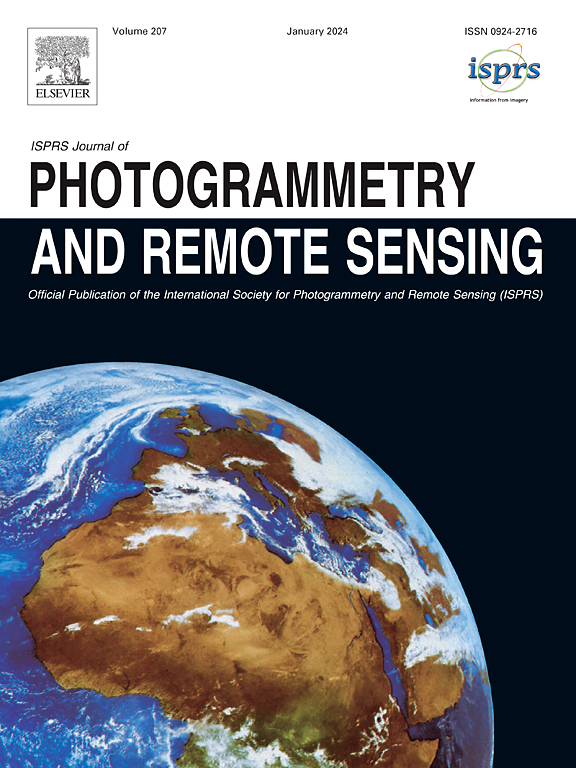使用不同几何形状的按需SAR数据进行连续洪水监测:COSMO-SkyMed图像的方法和测试
IF 10.6
1区 地球科学
Q1 GEOGRAPHY, PHYSICAL
ISPRS Journal of Photogrammetry and Remote Sensing
Pub Date : 2025-05-09
DOI:10.1016/j.isprsjprs.2025.04.036
引用次数: 0
摘要
当发生大洪水时,卫星数据对向应急管理人员提供受灾地区的频繁和天气图很有用,甚至可以每天提供一次。只有使用按需SAR数据,才能在不同地区不分昼夜、不受云层覆盖的情况下,对洪水事件进行高分辨率监测。然而,连续洪水制图通常需要将获取的图像与不同的传感器参数相结合。反过来,这使得数据解释和处理相当具有挑战性,并且可能需要耗时的可视化分析活动,这与每天向最终用户快速交付洪水地图的要求形成鲜明对比。本文提出了一种利用按需SAR数据进行近实时连续洪水监测的新方法。它实现了一个完整的工作流程,从卫星任务和洪水前参考图像收集到洪水地图生成。该方法的核心是一种新的基于变化检测的自动化算法,该算法可以处理不同成像几何形状捕获的数据。该算法旨在区分由于场景变化引起的变化和由于图像采集参数可能存在差异引起的变化。它应用了不同的图像处理技术,如聚类、直方图均衡、模糊逻辑和区域增长,并实现了两种电磁模型。该算法还辅以一个后期处理步骤,其目的是使每日洪水图相互一致。该方法在2023年5月袭击意大利(艾米利亚-罗马涅地区)的一次大洪水中进行了测试,使用cosmos - skymed数据和基准洪水地图,这些洪水地图来自光学数据和哥白尼应急管理服务(CEMS)的快速测绘组件。此外,将其应用于2023年11月意大利(托斯卡纳地区)的另一次洪水事件,并提供了基准CEMS产品,以进一步评估其可靠性。在这些案例研究中,该算法获得了从76%到90%不等的f1分数,这表明,即使使用非最佳几何形状获取的数据,该方法也能产生可靠的结果。这些结果与文献中报道的变更检测方法一致,这些方法应用于来自相同轨道的获取,以及半自动化监督工作流,如CEMS使用的那些。该算法的伪代码可在:https://github.com/LucaP-CIMA/AUTOWADE2.0-pseudocode。本文章由计算机程序翻译,如有差异,请以英文原文为准。
Continuous flood monitoring using on-demand SAR data acquired with different geometries: Methodology and test on COSMO-SkyMed images
When large floods occur, satellite data are useful for providing emergency managers with frequent and synoptic maps of affected areas, even on a daily basis. Only the use of on-demand SAR data enables the high-resolution monitoring of flood events through acquisitions performed day and night, and regardless of cloud cover, over different areas. However, continuous flood mapping generally requires combining images acquired with different sensor parameters. In turn, this makes data interpretation and processing quite challenging and might require a time-consuming visual analysis activity, which contrasts with the requirement of fast daily delivery of flood maps to end-users.
This paper presents a new methodology designed to perform continuous flood monitoring in near real-time using on-demand SAR data. It implements a complete workflow, ranging from satellite tasking and pre-flood reference image collection to flood map generation. The core of the methodology is a new automated algorithm based on change detection that can work with data captured with different imaging geometries. The algorithm is designed to discriminate the change due to the change in the scenario from that due to possible differences in the acquisition parameters of the images. It applies different image processing techniques, such as clustering, histogram equalization, fuzzy logic, and region growing, and implements two electromagnetic models. The algorithm is complemented by a post processing step whose objective is to make the daily flood maps consistent with each other. The methodology was tested on a major flood that hit Italy (Emilia-Romagna region) in May 2023, using COSMO-SkyMed data and benchmark flood maps derived from optical data and from the Rapid Mapping component of the Copernicus Emergency Management Service (CEMS). Additionally, it was applied to another flood event that occurred in Italy (Tuscany region) in November 2023, for which benchmark CEMS products were also available, to further assess its reliability. Across these case studies, the algorithm achieved F1-scores ranging from 76% to 90%, demonstrating that, even when using data acquired with geometries that are non-optimal for flood mapping, the methodology produces reliable results. These results are consistent with those reported in the literature for change detection methods applied to acquisitions from the same orbit and for semi-automated supervised workflows such as those used by CEMS.
The pseudocode of the algorithm is available at: https://github.com/LucaP-CIMA/AUTOWADE2.0-pseudocode.
求助全文
通过发布文献求助,成功后即可免费获取论文全文。
去求助
来源期刊

ISPRS Journal of Photogrammetry and Remote Sensing
工程技术-成像科学与照相技术
CiteScore
21.00
自引率
6.30%
发文量
273
审稿时长
40 days
期刊介绍:
The ISPRS Journal of Photogrammetry and Remote Sensing (P&RS) serves as the official journal of the International Society for Photogrammetry and Remote Sensing (ISPRS). It acts as a platform for scientists and professionals worldwide who are involved in various disciplines that utilize photogrammetry, remote sensing, spatial information systems, computer vision, and related fields. The journal aims to facilitate communication and dissemination of advancements in these disciplines, while also acting as a comprehensive source of reference and archive.
P&RS endeavors to publish high-quality, peer-reviewed research papers that are preferably original and have not been published before. These papers can cover scientific/research, technological development, or application/practical aspects. Additionally, the journal welcomes papers that are based on presentations from ISPRS meetings, as long as they are considered significant contributions to the aforementioned fields.
In particular, P&RS encourages the submission of papers that are of broad scientific interest, showcase innovative applications (especially in emerging fields), have an interdisciplinary focus, discuss topics that have received limited attention in P&RS or related journals, or explore new directions in scientific or professional realms. It is preferred that theoretical papers include practical applications, while papers focusing on systems and applications should include a theoretical background.
 求助内容:
求助内容: 应助结果提醒方式:
应助结果提醒方式:


